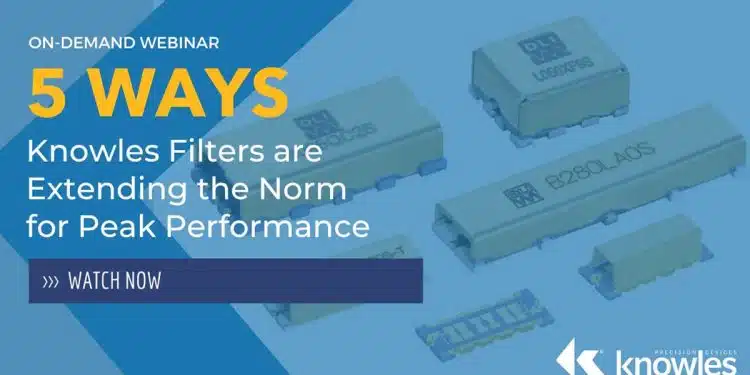In the webinar “5 Ways Our Filters Are Extending the Norm for Peak Performance” Knowles Precision Devices reviews and challenge how some aspects of microwave technology have advanced beyond traditional assumptions. Looking at several examples on RF and Microwave filter technologies and applications, it shows some exceptions to the rules and how to spot an opportunity to challenge conventional thinking.
Thanks to material and design advances, practice can often extend beyond convention. We illustrate this point first by sharing the basics of four technologies used to build RF and Microwave Filters: lumped element filters, microstrip filters, coaxial ceramic resonator, and cavity filters. Then, we explore, and challenge, the following common assumptions about these different filters:
Common Assumption #1: Certain Filters Create a Certain Q Factor
Industry textbooks show a common theme, cavity filters have the highest Q factor and lumped elements have the lowest Q factor, while microstrip and coaxial fit nicely in the middle. But if you look at industry data on Q factor ranges, you see a slightly different picture as Q factor ranges become more overlapped. This is due to advances in both materials and design techniques, allowing Knowles Precision Devices, for example, to expand Microstrip beyond the conventional capabilities one would expect.
Common Assumption #2: Lumped Element Filters Aren’t Practical Beyond L Band & Are Seldom Implemented above 6 GHz
We can make lumped element filters at 20GHz. Also, these filters can be adjusted for some of the fastest and most flexible prototyping options that’s hard to match with other technologies.
Common Assumption #3: Cavity Filters are Large
Cavity filters come in many distinctive forms. Some cavity filters can be the size of a shoebox while others can fit in the palm of your hand or even the tip of your fingertip. Alternative dielectrics can be designed to reduce the size of the cavity and waveguide filter. In the webinar we look at the relationship between the physical size of a filter and its operating frequency and how ‘large’ is relative depending on the frequency of interest.
Common Assumption #4: Microstrip Filters are Low Q
We commonly see people making real-world decisions based on what the industry believes filters are capable of. The industry likes to assume microstrip filters are reserved for received or small-signal applications where size and channel count drive the need for a small custom filter but there is a lot of variability and flexibility possible with microstrip filters. There are also many factors that play a role in driving higher Q, even at high frequencies, which is important because we are using a much higher frequency spectrum than we were in the past.
Common Assumption #5: Microstrip Filters Can’t Handle Power
A commonly believed limitation of microstrip filters is that they can’t handle more than 5 watts of power, but we’ve created microstrip filters that can actually handle up to 18 watts.
In summary, technology has improved and changed, and we need to start questioning if yesterday’s assumptions are still the case today. As shown in this webinar, we’ve started to prove that the entire industry is doing things textbooks said couldn’t be done. Download this on-demand webinar to learn more about these common misconceptions of microwave filters and see why it’s time to move past them.
































